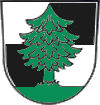Moxa
| coat of arms | Germany map | |
|---|---|---|

|
Coordinates: 50 ° 38 ' N , 11 ° 38' E |
|
| Basic data | ||
| State : | Thuringia | |
| County : | Saale-Orla district | |
| Management Community : | Ranis-Ziegenrück | |
| Height : | 430 m above sea level NHN | |
| Area : | 4.72 km 2 | |
| Residents: | 75 (Dec. 31, 2019) | |
| Population density : | 16 inhabitants per km 2 | |
| Postal code : | 07381 | |
| Area code : | 036483 | |
| License plate : | SOK, LBS, PN, SCZ | |
| Community key : | 16 0 75 069 | |
| Association administration address: | Pößnecker Str. 2 07389 Ranis |
|
| Website : | ||
| Mayoress : | Karin Knoll | |
| Location of the municipality of Moxa in the Saale-Orla district | ||
Moxa is a municipality in the Ranis-Ziegenrück administrative community in the Saale-Orla district in Thuringia .
location
Moxa is located in the southeast of Thuringia slate mountains . The hills and heights to the west of the Saale Dam are wooded. The town of Ziegenrück is to the south and Pößneck to the north . Moxa has good transport connections. The state roads 1102, 1104 and 1100 cover the village.
history
Moxa is first documented in 1295. During the Thirty Years War , the village was completely destroyed by fire. The medieval Sornitzburg, on the right of the path to Ziegenrück, was also devastated in 1640 ( Sornitz ). The village was then rebuilt above the former settlement area in the form of an anger square village. The site of the moated castle was converted into a pond in 1884. The name Moxa is of Sorbian origin and changed over the years from Mugczow or Moxzow to today's spelling Moxa . The place belonged to the electoral office of Ziegenrück until 1815 and after its assignment, decided at the Congress of Vienna , came to the Prussian district of Ziegenrück , to which the place belonged until 1945.
Population development
Development of the population (from 1994: as of December 31) :
|
|
|
|
|
- Data source from 1994: Thuringian State Office for Statistics
politics
Mayoress
Karin Knoll has been mayor since 2004 and was re-elected in 2010 and 2016.
coat of arms
The municipality of Moxa has its own coat of arms with the following blazon : “The coat of arms depicts a strong spruce tree in green. The background of the coat of arms is quartered above the wavy line that represents the forest floor. The opposite surfaces are of the same color. The upper right and lower left surfaces are black, the upper left and lower right surfaces are silver. The background in the root area is white. "
flag
The municipality does not fly its own flag, but uses the flag of the state of Thuringia.
education
The geodynamic observatory Moxa of the Friedrich Schiller University Jena and the center for engineering analysis of earthquake damage of the Bauhaus University Weimar are located on the edge of the village . Records of earthquakes around the world are kept and evaluated here.
Web links
Individual evidence
- ^ Population of the municipalities from the Thuringian State Office for Statistics ( help on this ).
- ^ Wolfgang Kahl : First mention of Thuringian cities and villages up to 1300. A manual. 2nd, improved edition. Rockstuhl, Bad Langensalza 2001, ISBN 3-934748-58-9 , p. 43.
- ↑ Michael Köhler : Thuringian castles and fortified prehistoric and early historical living spaces. Jenzig-Verlag Köhler, Jena 2001, ISBN 3-910141-43-9 , p. 235.
- ^ A b Michael Rademacher: German administrative history from the unification of the empire in 1871 to the reunification in 1990. Ziegenrück district. (Online material for the dissertation, Osnabrück 2006).
- ↑ http://wahlen.thueringen.de/datenbank/wahl1/wahl.asp?wahlart=BM&wJahr=0000&zeigeErg=GEM&auswertung=1&wknr=075&gemnr=75069&terrKrs=&gemteil=000&buchstabe=&Langname=&wahlvorschlag=&sort=&druck=&XLS=&anzahlH=- 6 & Non_existing = & x_vollbildDatteil = & optik = & aktuell = & ShowLand = & ShowWK = & ShowPart = & w_date = 13.06.1999
- ↑ Main statute of the municipality of Moxa from August 12, 2003 § 3 Paragraph 1 ( Memento from March 6, 2016 in the Internet Archive ) ( MS Word ; 46 kB)
- ↑ Main statute of the municipality of Moxa of August 12, 2003, Section 3, Paragraph 2 ( Memento of March 6, 2016 in the Internet Archive ) ( MS Word ; 46 kB)



